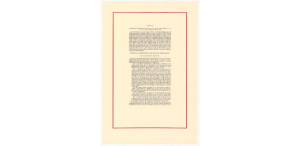The Feminine Mystique, Betty Friedan, 1963

The Feminine Mystique, a book written by Betty Friedan in 1963, was a revolutionary piece of literature that many believe ignited the start of the second wave of feminism. Friedan wrote the piece in hopes of encapsulating the identity crisis that many women felt during their day to day lives within the household. Friedan famously dubbed this internal conflict as “the problem that has no name.” Friedan makes a point in her work that this sense of emptiness was due to the cult domesticity ideals that were pressed into society during the 1950s at the start of the Cold War. (Turner) Friedan then goes on to argue the idea that the role of women in society as just a domestic entity hinders them from growing and having any form of independent identity. Her conclusion is that women should go on to pursue education and careers outside of the household to progress and achieve their own identity. These ideas were groundbreaking for the social climate of the 1960s which then caused a stir amongst women to begin to break out of the mold and pursue their own interests. This book is still referenced today due to how powerful the message of pursuing autonomy was the first of its time given by Betty Friedan.
“Men Without Women”: Look Magazine, Eleanor Harris 1960
The article written in Look Magazine by Eleanor Harris pointed out the clear double standard between men and women in society during the 1960s. Harris comments on the fact that men and women have differing reasons for being single and unmarried. Harris differentiates the two common reasons by saying that men often say they are single because they haven’t found a woman who fits their needs of domesticity. On the other hand, woman who are unmarried are labeled as “undesirable”. She makes it clear that the dynamic relationships and marriages solely focuses on the needs of the men and the women are there to fill their needs. This article shares the same ideas of identity for women during the time and helps try to go against the dominant culture that was commonplace in relationship culture during the 1950s and 1960s. Harris attempts to empower women by helping them recognize this flaw and encourage them to think differently and practice self-love. This source shows the burgeoning presence of the Feminist Movement that was on the horizon.
Title IX, 1972

Title IX was an act that was passed in 1972 to enforce the equality of all and put an end to discrimination in the workplace, in academics (specifically higher education) and in athletics as well. Women could pursue careers that required higher education such as doctorates and also gain employment without being discriminated based on sex. This set of laws help push women forward in terms of equality and opened up a world of opportunity that they had not had before. Some women refer to themselves as “Title IX Babies” who felt they had seized the opportunity and had capitalized on the newly enforced rules and regulations in athletics and academics. (Leung) The opportunity allowed women to step out of the “feminine mystique” that Betty Friedan detests in her book shown earlier. Title IX has been one of the most powerful set of laws enacted since the 19th Amendment and has helped move women towards equality in the present day as well.
